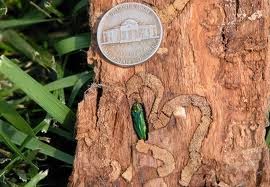by Stanton Gill (Landscape and Nursery IPM Weekly Report, University of Maryland Extension, April 25, 2014)
[The Landscape and Nursery IPM Weekly Report is a publication of the University of Maryland Extension Service for professional horticulturalists]
The western part of Maryland from the Chesapeake Bay to Garrett County is in a quarantine situation for
emerald ash borer. The emerald ash borer has been found in Calvert, Anne Arundel, Howard, Frederick,
Washington, Alleghany, Garrett and St. Mary’s counties. We talked with experts from the mid-west who have
had to deal with the dilemma of the emerald ash borer in the mid-west. They commented that you go through
about 3 or 4 years of discovery of the pest in an area followed by a tidal wave of dying trees. We in Maryland
are still in the discovery stage of this insect infestation.
If your customers can keep a valuable ash tree alive through the tidal wave then the population goes down
and you are hopefully left with standing trees. The questions are how much are you are willing to spend on
protecting the ash trees and for how long? There is no natural resistance to the emerald ash borer among ash
trees. Controlling insects feeding under bark of trees is very difficult. In university trials, they have found that
treatments of some ash trees worked very well in some sites and the same treatment in other ash tree sites failed.
Also, in some studies conducted over multiple years, EAB densities continued to increase in individual trees
despite annual treatment.
Some arborists have combined treatments to increase the odds of success (e.g. combining a cover spray with
a systemic treatment). It is best to inform a customer that this treatment is the best you can do and do not guarantee control with insecticide treatments. Imidacloprid and dinotefuran should provide control for one
season. Ash are wind pollinated and not pollinated by insects so applications of neonicotinoids should have no major impact on pollinators.



Neonicotinoids? Imidocloprid? These are the chemicals that Europe has targeted as likely suspects in honey bee hive decline.
ReplyDeleteIn my opinion, better safe than sorry.
Check the pesticides you are using. If they contain "neonicotinoids" or "Imidocloprid," just say, "No."